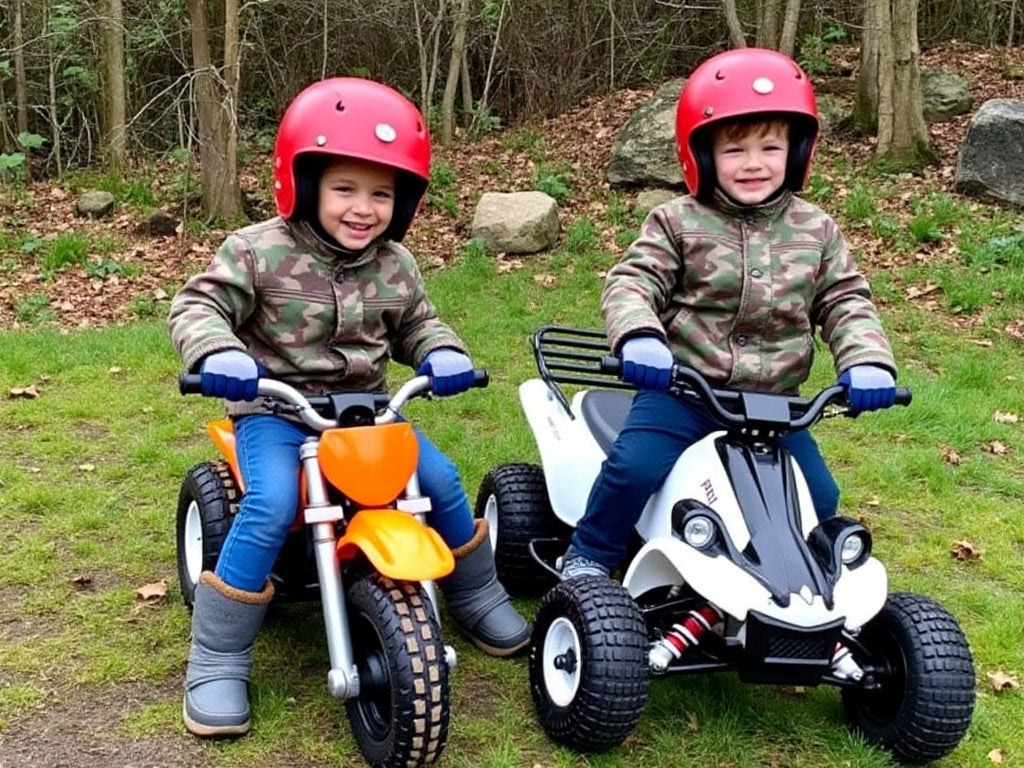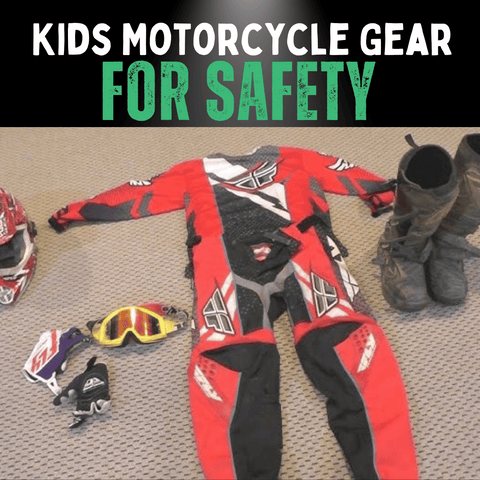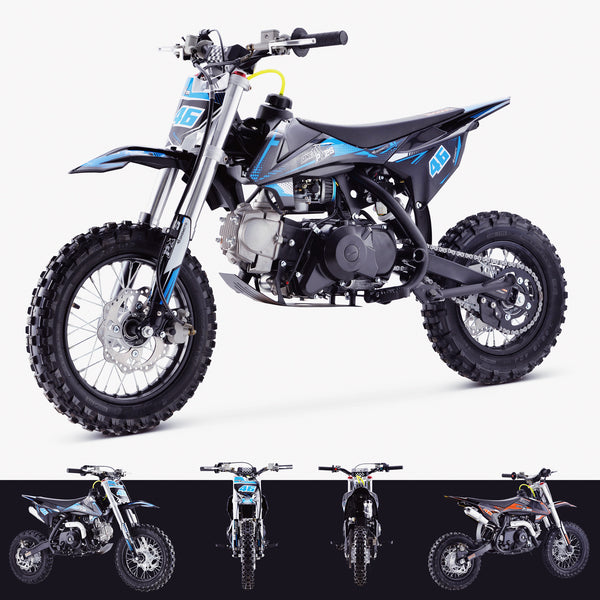Before You Buy: Essential Questions
Choosing the right ride-on motorbike for your child can feel overwhelming with so many options available.
Before you start shopping, take a moment to consider these crucial questions that will guide your decision-making process.
First, consider your child's age and development. While age recommendations are helpful starting points, every child develops differently.
Your three-year-old might have the coordination of a four-year-old, or your five-year-old might need more time to develop confidence. Watch how they handle other ride-on toys to gauge their readiness.
Next, think about where the bike will primarily be used. A bike that's perfect for smooth indoor surfaces might struggle on your gravelly driveway.
Consider your available space – both for riding and storage. Indoor riders need space to maneuver safely, while outdoor riders need a secure, weather-protected storage area when not in use.
Your budget plays a crucial role, but remember to think beyond the initial purchase price.
Factor in essential safety gear, potential maintenance costs, and accessories you might need.
A quality bike might cost more upfront but could save money in the long run through better durability and fewer repairs.
Step-by-Step Buying Guide

1. Find the Right Size
Proper sizing is crucial for both safety and enjoyment. Think of it like buying shoes – too big is dangerous, and too small is uncomfortable.
When your child sits on the bike, they should be able to plant both feet firmly on the ground while maintaining an upright posture.
Their hands should reach the handlebars with a slight bend in their elbows, allowing for comfortable control without stretching.
For children ages 1-3, look for bikes with 6V motors and seat heights between 12-14 inches.
These smaller bikes prioritise stability and gentle movement, perfect for building confidence.
As your child grows into the 3-5 age range, 12V motors and slightly higher seats (14-16 inches) provide more excitement while maintaining safety.
The 5-7 age group can typically handle 24V motors with seat heights of 16-18 inches, offering more speed and features for developing riders.
For experienced riders over 7, 36V-48V motors and 18+ inch seats deliver more thrilling rides while maintaining safety through parental controls.
Remember that your child should be able to mount and dismount independently.
If they're struggling with this basic movement, the bike is likely too large or heavy for them to handle safely.
2. Safety First

Safety features aren't just add-ons – they're essential protections that could prevent serious accidents.
The most critical safety feature to look for is a parental remote control with emergency stop functionality.
Think of it as your safety net; no matter how careful your child is, having the ability to stop the bike instantly from a distance provides crucial peace of mind.
Speed governors are another non-negotiable feature. These allow you to set maximum speeds appropriate for your child's skill level and gradually increase them as they gain confidence.
Look for bikes with at least 2-3 speed settings that you can adjust as your child develops.
The bike's physical construction matters tremendously. A stable wheelbase prevents tipping, while quick-stop brakes ensure reliable stopping power.
Non-slip handgrips keep little hands firmly in control, and an enclosed chain or belt drive system protects curious fingers from moving parts.
All edges should be rounded, and the body should be made of durable, impact-resistant materials.
Advanced safety features like spring suspension systems and anti-tip wheels provide extra protection but shouldn't be relied upon as primary safety measures.
They complement basic safety features and enhance the riding experience.
3. Choose Your Power Level
Selecting the right power level is about balancing fun with safety.
Think of it like choosing a first bicycle – you want something challenging enough to be exciting but not so powerful that it overwhelms your child.
| Battery | Speed Range | Runtime | Charging Time | Best For |
|---|---|---|---|---|
| 6V | 2-3 mph | 45-60 min | 8-10 hrs | Indoor/Beginners |
| 12V | 3-5 mph | 1-2 hrs | 10-12 hrs | Light outdoor use |
| 24V | 5-8 mph | 2-3 hrs | 12-14 hrs | Regular outdoor use |
| 36V-48V | 8-13 mph | 3-4 hrs | 14-18 hrs | Experienced riders |
6V systems are perfect for indoor use and absolute beginners. With speeds of 2-3 mph, they're fast enough to be fun but slow enough to build confidence.
These bikes typically run for 45-60 minutes on a charge, ideal for shorter play sessions. The charging time of 8-10 hours means overnight charging works well for most families.
12V systems strike a sweet spot for many families. They offer speeds of 3-5 mph – about the pace of a brisk walk – and run for 1-2 hours per charge.
This power level works well both indoors and out, making them versatile choices for growing riders. Expect charging times of 10-12 hours.
24V systems bring more excitement with speeds of 5-8 mph and extended 2-3 hour run times.
These are best suited for outdoor use where riders have plenty of space to maneuver.
The additional power handles slight inclines well and maintains consistent speed on varying surfaces. Plan for 12-14 hour charging periods.
For experienced riders, 36V-48V systems deliver thrilling performance with speeds of 8-13 mph and impressive 3-4 hour run times.
However, these powerful bikes require mature judgment and well-developed riding skills. The longer charging times of 14-18 hours mean planning ahead is essential.
4. Match to Your Environment
Choosing a bike that matches your riding environment is crucial for both safety and enjoyment.
Let's explore how different environments demand different features.
Indoor Riding If your child will primarily ride indoors, focus on bikes designed for confined spaces.
Look for:
- Smooth, non-marking tyres that won't damage flooring
- Whisper-quiet motors to maintain household peace
- Tight turning radius for navigating indoor spaces
- Lightweight construction for easy maneuvering
- Lower maximum speeds suitable for indoor safety
The ideal indoor bike should be easy to control and won't leave marks or scratches on your floors.
Consider the spaces where the bike will be used – hallways, living areas, and playrooms all need different amounts of maneuverability.
Outdoor Riding Outdoor environments demand more robust features to handle various conditions:
- All-terrain tyres with deep treads for better grip
- Enhanced ground clearance to handle uneven surfaces
- Weather-resistant materials that won't rust or degrade
- Robust suspension system for a smoother ride
- Sealed electrical components to protect against moisture
For mixed terrain, look for bikes with:
- Heavy-duty shock absorbers
- Reinforced frame construction
- Extra-wide tyres for enhanced stability
- More powerful motors capable of handling inclines
- Protective skid plates for undercarriage protection
5. Petrol Motorbikes: A Step Up to Real Power
For families considering a more authentic riding experience, petrol motorbikes offer an exciting but more demanding alternative to electric models.
These bikes represent a significant step up in both performance and responsibility, requiring careful consideration before making the switch.
Understanding Petrol Power
Think of petrol motorbikes as miniature versions of adult motorcycles rather than toys.
They feature real engines ranging from 50cc to 110cc, delivering authentic riding experiences complete with engine sounds, vibrations, and the need for actual mechanical understanding.
Unlike electric bikes that start with a button press, these machines teach children about basic engineering and mechanical responsibility.
Age and Skill Requirements
Petrol bikes demand more maturity and skill than their electric counterparts. Here's how to match your child with the right engine size:
-
50cc Bikes (Ages 6-9) Perfect for beginners, these bikes offer manageable power while teaching basic riding skills. Top speeds typically range from 15-20 mph, though they should be restricted for new riders.
-
70cc Bikes (Ages 8-11) Ideal for intermediate riders who have mastered basic skills. These bikes offer more power and speed, suitable for both trail riding and basic track use.
-
90cc Bikes (Ages 10-13) For advanced young riders with several years of experience. These bikes provide enough power for competitive riding while maintaining manageable characteristics.
-
110cc Bikes (Ages 12+) Reserved for experienced riders, these bikes deliver adult-level performance and require significant skill to operate safely.
Safety Considerations
Petrol bikes require a more comprehensive approach to safety than electric models:
-
Protective Gear
- Full-face helmets are mandatory
- Heavy-duty riding boots that protect against hot engine parts
- Fire-resistant riding gear
- Chest and back protectors
- Professional-grade gloves
-
Environmental Safety
- Dedicated riding area away from structures
- Proper fuel storage and handling procedures
- Fire safety equipment nearby
- Well-ventilated storage area
- First aid kit designed for potential burns
Maintenance Requirements
Owning a petrol bike means embracing regular maintenance as part of the riding experience:
Weekly Tasks:
- Check oil levels and condition
- Clean air filter
- Inspect chain tension
- Check tire pressure and wear
- Verify all controls work smoothly
Monthly Requirements:
- Change oil (if used regularly)
- Deep clean air filter
- Adjust and lubricate chain
- Check spark plug condition
- Inspect brake pads and cables
Seasonal Maintenance:
- Carburetor cleaning and adjustment
- Valve clearance check
- Complete chassis inspection
- Deep clean fuel system
- Professional safety inspection
Cost Considerations
Petrol bikes represent a significant investment beyond the initial purchase:
Upfront Costs (£500-£2000+)
- The bike itself
- Complete safety gear set
- Basic tool kit
- Transport equipment
- Storage solutions
Ongoing Expenses:
- Fuel costs (varies with usage)
- Regular maintenance parts
- Oil and lubricants
- Replacement wear items
- Insurance coverage
Space and Storage Requirements
Before purchasing a petrol bike, ensure you have:
- A secure, well-ventilated storage area
- Safe fuel storage facilities
- Adequate transport means (trailer or truck)
- Access to appropriate riding areas
- Space for maintenance work
The Learning Curve
Unlike electric bikes, petrol models require understanding:
- Basic engine operation
- Manual clutch control (on most models)
- Gear shifting techniques
- Mechanical sympathy
- Fuel mixture ratios
- Basic maintenance procedures
Professional instruction is strongly recommended for:
- Initial riding techniques
- Safety protocols
- Basic maintenance
- Emergency procedures
- Advanced skill development
Remember: While petrol bikes offer an exciting step up in the motorcycling world, they represent a significant commitment in terms of time, money, and responsibility.
They're best suited for families ready to embrace motorcycling as a serious hobby rather than casual recreation.
6. Consider the Budget

Understanding what different price points offer helps make an informed decision that balances features with cost.
Entry-Level (£100-£200) These basic models provide:
- Essential safety features
- Simple, durable design
- Basic battery system
- Standard wheels and tyres
- Manual speed control
While these bikes offer good value for beginners, they may lack advanced features and could have shorter lifespans.
Mid-Range (£200-£500) The sweet spot for many families, offering:
- Enhanced safety features
- Better build quality
- Longer battery life
- Improved comfort features
- Basic parental controls
- More reliable components
These bikes typically provide the best balance of features, durability, and value.
Premium (£500+) Top-tier bikes include:
- Advanced safety systems
- Maximum runtime
- Superior suspension
- Multiple speed settings
- Premium materials
- Extended warranties
- Advanced parental controls
- Enhanced comfort features
While expensive, these bikes often last longer and can be passed down to siblings.
Essential Safety Checklist
Safety gear is non-negotiable – it's as important as the bike itself.
Here's what your child needs before their first ride:
Helmet Protection
- DOT-approved helmet that fits properly
- Should be snug but not tight
- No movement when the head shakes
- Clear field of vision
- Proper ventilation
Body Protection
- Impact-resistant knee pads with secure straps
- Durable elbow guards that stay in place
- Wrist protectors to prevent sprains
- Closed-toe shoes with ankle support
- Protective eyewear for outdoor riding
- Riding gloves for better grip and hand protection
High-visibility clothing helps make your child more visible, especially in low-light conditions or shaded areas.
Maintenance Tips
Regular maintenance extends your bike's life and ensures safe operation.
Here's a comprehensive maintenance routine:
Weekly Checks
-
Battery Care
- Check voltage levels
- Clean terminals
- Inspect for damage
- Verify proper charging
-
Tyre Maintenance
- Check pressure (if applicable)
- Inspect for wear
- Clean thoroughly
- Check alignment
-
Safety Systems
- Test brakes
- Verify steering response
- Check safety switches
- Test parental controls
Monthly Tasks
-
Deep Cleaning
- Wash entire bike
- Dry thoroughly
- Polish painted surfaces
- Clean all moving parts
-
Mechanical Inspection
- Lubricate moving parts
- Check all fasteners
- Inspect wiring
- Test all features
-
Performance Testing
- Verify speed settings
- Check battery runtime
- Test all functions
- Assess motor performance
Red Flags to Watch For

When shopping, be alert for these warning signs that could indicate poor quality or safety concerns:
Design Issues
- Sharp edges or exposed metal
- Unstable when standing still
- Wobbly wheels or steering
- Exposed wiring or components
- Poor quality plastics
Safety Concerns
- Missing or disabled speed limiters
- No parental remote control
- Weak or unreliable brakes
- Unstable at higher speeds
- Poor customer reviews mentioning safety
Quality Problems
- Short warranty periods
- Limited parts availability
- Poor customer service
- Inconsistent power delivery
- Frequent mechanical failures
Before First Ride
Follow this detailed preparation process before your child's inaugural ride:
-
Complete Setup
- Charge battery fully (12-18 hours initially)
- Verify all assembly points
- Test all controls thoroughly
- Check tyre pressure
- Ensure all safety features work
-
Location Preparation
- Choose a flat, open area
- Remove any obstacles
- Ensure good visibility
- Mark clear boundaries
- Set up a practice course
-
Rider Training
- Practice proper mounting
- Teach basic controls
- Demonstrate emergency stops
- Review safety rules
- Start at lowest speed
- Practice basic maneuvers
Recommended Accessories
Enhance your child's riding experience with these carefully chosen accessories:
Essential Items
- Spare battery for extended play
- Basic cleaning supplies
- Multi-tool kit
- Storage cover
- Battery tester
- First aid kit
Comfort Additions
- Seat cushion
- Handle grips
- Weather protection
- Storage compartments
- Drink holder
Remember: The right choice balances your child's age, skill level, and intended use with appropriate safety features and your budget constraints.
Prioritise safety features over entertainment additions, and always ensure proper supervision during use.
With this guide, you're well-equipped to choose the perfect ride-on motorbike for your child.
Take your time making the decision, and remember that safety and appropriateness for your child's development level should always be the top priorities.
Get in Touch 🚀
Loved our article on “How to Choose a Kids Ride-on Motorbike: A Parent's Complete Guide” Got the itch to dive into more wheely-awesome info?
Whether you're a parent or a grandparent, we're here for all your kids ride-on toy questions! 🚗💨
Feeling click-happy?
Jump straight into our wonderland at RiiRoo.com.
Or, if you're more the chatty type, give our Live Chat a whirl and let's talk toys!








Share:
Top 10 Essential Dirt Bike Accessories for Beginners: Gear Up for Safety and Fun
Read This Before You Buy Your Kid An Electric Quad Bike!